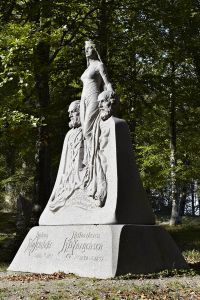Skibelund Krat
Today Skibelund Krat serves as a memorial park, but once upon a time it was an important meeting place for pro-Danish North- and South Jutlanders. On the south-facing slope, a meeting site was created with seating for about 4,000 people.
The highlight of the year was the constitutional meeting where the themes were democracy and Danishness. Surrounding the meeting place and out in the countryside, memorial stones were erected for people who had actively participated in the struggle for Danishness in South Jutland. In around 1900, the memorial stones were supplemented by the works of art "Magnusstenen" and "Modersmålet".
Skibelund Krath's history is inextricably linked to the history of South Jutland, Kongeåen as a border and the high schools Rødding and Askov.
Constitutional meetings
After the defeat in 1864, Rødding high school was homeless and moved to Askov. In 1865, the local Grundtvigian peasants with close links to Rødding and Askov high schools, took the initiative to hold the first constitutional meeting in Skibelund Krat. It was the start of a more than century-old tradition.
The meetings in Skibelund Krat were of a national, not political nature. They came to form the pattern for high schools' national constitution meetings, where the key concepts were democracy and patriotism. In the period 1865 to 1920, the meetings in Skibelund Krat were an important ideological bridgehead in the fight for Danishness in South Jutland. At the constitution meetings, the Southern Jutlanders could be strengthened in their daily struggle for being pro-Danish. Here they dared to speak against the German authorities.
 Constitutional meeting in Skibelund Krat.
Constitutional meeting in Skibelund Krat.Photo: Vejen Lokalhistoriske Arkiv.
In 1865, Skibelund Krat was privately-owned, but in 1869 came the wish to erect a memorial stone for Jacob Christian Lindberg at the site. This provided the impetus for the creation of Skibelundforeningen (Skibelund Association), which still owns and runs Skibelund Krat today.
 Constitutional meeting in Skibelund Krat around 1910.
Constitutional meeting in Skibelund Krat around 1910. Photo: Vejen Lokalhistoriske Arkiv.
Memorial stone
The monuments have a special place in the national struggle. Surrounding the assembly area are memorial stones to the men and women who actively participated in the national struggle that was fought from Skibelund Krat. The stones were involved in the meetings in a symbiosis with speeches and community singing.
Modersmålet and Magnusstenen
The artworks Modersmålet (1903) and Magnusstenen (1898) were erected high on the cliff. The artworks contain strong national messages and it was therefore important that they were also visible from the German side of the river Kongeå.
In Louis Schrøder's words, the memorial stones and artworks were important pieces of the puzzle that make up our shared history as a nation. They were pages in Denmark's Memorial book.
Literature
Klitmøller, Linda: Grundlovsmøder i Skibelund Krat. I Sønderjysk Månedsskrift, 2013 nr. 5, p. 181-188.
Adriansen, Inge: Skibelund Krat. Et Grundtvigiansk nationalmonument. I bogen Erindringssteder i Danmark. Monumenter, mindesmærker og mødesteder, 2010, p. 283-289.
Nielsen, Teresa: Niels Skovgaard: Magnusstenen. I Mark og Montre, årg. 42, 2006, p. 113-122.
Nielsen, Teresa: Modersmålet fejrer 100 års fødselsdag. I Mark og Montre, årg. 39, 2003, p. 77-87.
Kelstrup, Gudmund: Skibelund. Træk af Skibelundforeningens historie gennem 100 år. I fra Ribe Amt, bd. 16, 1965, p. 161-240.
Author: Linda Klitmøller, museum curator, Sønderskov Museum

Modersmålet

Magnusstenen

